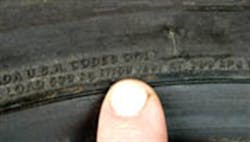Paying attention to a replacement tire's load rating is critical. The tire must be able to safely support a given amount of vehicle weight. If the tire's load rating is insufficient, the tire may become overheated and can self-destruct.
For example, if a passenger car performance tire is selected to replace an original equipment light truck tire on an SUV, the new tire must meet or exceed the requirement for the specific vehicle weight.
In order to roughly determine the load capacity for each individual tire, take the vehicle's gross weight and divide by four. If the vehicle gross weight is 4,500 pounds, each tire should be able to safely support at least 1,125 pounds.
However, the gross vehicle weight of the vehicle does not take additional load, such as the weight of the driver, into account. So you should never select a tire that only meets this minimum weight capability.
Always select a tire that offers a greater, or "reserve," load capacity, which will help the vehicle handle and respond to higher-stress emergency situations when loaded.
The tire's load rating, or "Max Load," indicates the individual tire's safe maximum load-carrying capacity when inflated to its recommended pressure. Never exceed a tire's maximum load rating (the limit that is molded into the tire sidewall), or the maximum vehicle load limit shown on the vehicle tire placard, whichever is less. The tire is designed and constructed to handle a specific maximum load, and overloading will result in a buildup of excessive heat in the tire which could lead to tire failure.
[PAGEBREAK]
The load index number, which appears on the tire sidewall, is an assigned number that corresponds to the tire's load carrying capacity. Alpha-numeric tires will display an alpha code that indicates maximum load. The letter can range from "A" to "N" (the higher the letter, the greater the load carrying capacity at a given inflation pressure).
The Max Load and maximum inflation numbers found on the tire sidewall indicate the maximum load that can safely be carried and the maximum allowable tire pressure. The construction of the tire (belts, bead, carcass, liner) dictates the tire's ability to withstand pressure. The stronger the reinforcements, the greater pressure the tire can hold.
Most alpha-numeric tires feature a load range of B, which indicates that they are restricted to the load that can be carried at a maximum inflation pressure of 32 psi. C, D or E tires are capable of greater loads. Most load range C, D and E tires are intended for light truck applications.
The load-carrying capacity of P-metric tires is rated as either Standard or Extra Load. Standard Load tires are limited by the load that can be supported with a maximum inflation pressure of 35 psi. Extra Load-rated tires are limited to the load that can be carried at a maximum inflation pressure of 41 psi. Generally, a Standard Load tire will not feature a special designation mark, while Extra Load tires will feature an "Extra Load" marking.
Extra Load tires will be branded as "Extra Load" and may be identified by an "XL" (for example: LT245/75R15 XL).
[PAGEBREAK]
It's important to note that a Standard Load tire (with a normal inflation pressure recommendation of 35 psi) may be marked with a maximum inflation pressure of 44 psi. This does not indicate an increase of the tire's load carrying capacity, but indicates the tire's ability to handle higher inflation pressure in order to accommodate special performance requirements.
Typically, the load indexes of passenger car tires and light trucks range from 70 to 110.
A speed-rated tire's sidewall markings will indicate size, followed by the load rating index and the speed rating. For examples, a P195/60R15 87S indicates that this tire carries a load rating of 87 and a speed rating of S; the load rating is 1,201 pounds and the speed rating is 112 mph. A 285/35ZR19 99Y tire carries a load rating of 99 and a speed rating of Y; the load rating is 1,709 pounds, and the speed rating is 186 mph.




